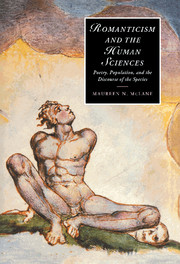Book contents
- Frontmatter
- Contents
- Acknowledgments
- Introduction, or the thing at hand
- Chapter 1 Toward an anthropologic: poetry, literature, and the discourse of the species
- Chapter 2 Do rustics think?: Wordsworth, Coleridge, and the problem of a “human diction”
- Chapter 3 Literate species: populations, “humanities,” and the specific failure of literature in Frankenstein
- Chapter 4 The “arithmetic of futurity”: poetry, population, and the structure of the future
- Chapter 5 Dead poets and other romantic populations: immortality and its discontents
- Epilogue: Immortality interminable: the use of poetry for life
- Notes
- Bibliography
- Index
- CAMBRIDGE STUDIES IN ROMANTICISM
Chapter 5 - Dead poets and other romantic populations: immortality and its discontents
Published online by Cambridge University Press: 22 September 2009
- Frontmatter
- Contents
- Acknowledgments
- Introduction, or the thing at hand
- Chapter 1 Toward an anthropologic: poetry, literature, and the discourse of the species
- Chapter 2 Do rustics think?: Wordsworth, Coleridge, and the problem of a “human diction”
- Chapter 3 Literate species: populations, “humanities,” and the specific failure of literature in Frankenstein
- Chapter 4 The “arithmetic of futurity”: poetry, population, and the structure of the future
- Chapter 5 Dead poets and other romantic populations: immortality and its discontents
- Epilogue: Immortality interminable: the use of poetry for life
- Notes
- Bibliography
- Index
- CAMBRIDGE STUDIES IN ROMANTICISM
Summary
Eternity and immortality are phrases to which it is impossible for us to annex any distinct ideas, and the more we attempt to explain them, the more we shall find ourselves involved in contradiction.
William Godwin, Political JusticeThe temporal immortality of the human soul, that is to say, its eternal survival after death, is not only in no way guaranteed, but this assumption in the first place will not do for us what we always tried to make it do.
Ludwig Wittgenstein, Tractatus Logico-PhilosophicusDeath is a displaced name for a linguistic predicament.
Paul de Man, “Autobiography as De-Facement”Wordsworth's “Ode: Intimations of Immortality from Recollections of Early Childhood” still stands as perhaps the representative English Romantic lyric. Less well known to non-specialists is Percy Shelley's powerful, disturbed response to Wordsworth and to Wordsworthian immortality, the long allegorical poem “Alastor; or, the Spirit of Solitude.” In Shelley's poem, a Wordsworthian spirit of solitude, in the person of a self-involved but sincerely questing poet, meets a bad end and goes to an “untimely tomb” (50). Whereas Wordsworth's Immortality Ode enacts the complex movements of a consciousness variously dejected, exultant, sobered, yet ultimately solaced by “the faith that looks through death” (187), Shelley's allegory polemically depicts a spirit permanently alienated, a poet prematurely yet decisively dead. From Wordsworth, intimations of immortality recollected from early childhood; from Shelley, a critical death, an insistence on mortality unredeemed and unredeeming.
- Type
- Chapter
- Information
- Romanticism and the Human SciencesPoetry, Population, and the Discourse of the Species, pp. 159 - 215Publisher: Cambridge University PressPrint publication year: 2000

